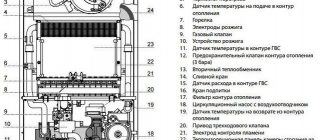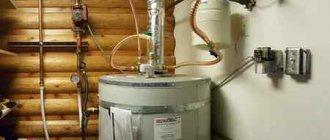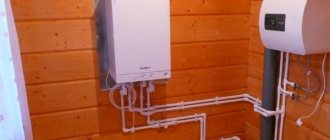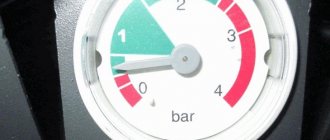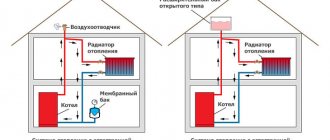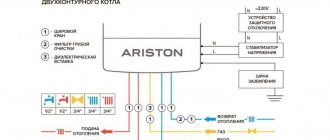Work to ensure the proper functioning of heating equipment does not end with its installation. Maintenance requires the owner to have a certain level of knowledge and constant monitoring of the condition of the system. It is important to understand why the pressure in a gas boiler drops or rises, which is why the equipment operates with fluctuations.
The article we presented describes in detail all the reasons for pressure instability in the coolant and hot water preparation system. We'll show you how to troubleshoot and keep your readings within normal range. Our recommendations will help you cope with emerging breakdowns and prevent operational failures.
What should be the pressure in the heating system?
Heating systems can be divided into two types - closed and open. When open, the pressure regulation function is performed by a leaky expansion tank.
The container is installed at the top point of the heating circuit and serves to hold the coolant expanding when heated, to remove air, and also acts as a safety valve. The operating pressure in such a system depends mainly on the temperature of the heating water.
Most often, when organizing heating in houses and apartments, closed heating systems are used. They are more effective and safe, but require constant pressure monitoring.
It is very important to monitor the pressure and temperature of the coolant, and respond to any signs that are not typical for the normal operation of the heating system - knocking, frequent discharge of hot water through the safety valve, cold sections of the circuit
The pressure in a closed-type circuit arises due to forced circulation carried out using a pump. Pressure deviations from the norm can lead to equipment failure.
The nominal pressure in gas boilers of different models may vary; it is determined by the technical characteristics of the equipment
When designing a heating system, the pressure is calculated taking into account the height of the water column, the length of the system, the characteristics of the connected equipment, and the cross-section of the pipes.
To adjust the working pressure, you need to focus on the following parameters:
- Technical characteristics of a gas boiler. The manufacturer indicates the capabilities of the equipment and its settings in the instructions.
- Coolant temperature. The higher the temperature, the greater the pressure in the circuit; as it decreases, it decreases. Therefore, setting and measuring the pressure in the gas boiler and heating circuit must be carried out before and after heating the coolant.
- Volume of the circuit and expansion tank. The size of the accumulator has a direct impact on the pressure in the heating circuit and the range of its fluctuation.
- Acceptable pressure indicators for the least “weak” element of the system. The pressure in the system should not exceed the permissible values for each of its elements. For example, polypropylene pipes, which on average are designed for a pressure of 25 bar at room coolant temperature, can withstand an increase in pressure only up to 7-9 bar at a temperature of 90 °C.
The minimum pressure in the circuit can be 0.5-0.8 bar, the exact standard values are indicated in the instructions, in accordance with them the pressure sensor is adjusted to the required value. If the pressure in the heating system drops below 0.5 bar, an emergency situation occurs, in which the gas boiler may stop or be damaged.
The highest pressure value in the system is up to 3, less often up to 4 bar. For a five-story building, pressure values are adjusted to 5 bar, for a ten-story building to 7 bar. When making settings, it is necessary to adhere to the difference in pressure between the outgoing and return pipes - it should be 0.3-0.5 bar. After starting the heating, check if this is the case.
Optimal value for a private house or cottage
The pressure in the heating system of a private house should not exceed the stability limit of one of the weakest components - the heat exchanger built into the boiler. The most durable devices can withstand pressure up to three atmospheres. The designation should not be confused with megapascal, since 1 unit of atmospheric pressure equals 0.1 MPa.
Elements located outside the boiler, for example, the radiator circuit, have a higher degree of strength and can withstand up to 6 atmospheres.
The solution to the problem of what pressure in the heating system of a private house is considered correct depends on the type of device.
Composition of a closed heating system
The standard type of device is an installation with conventional, or rather natural circulation of heating fluid, which is called a thermosiphon or gravity installation. In this case, the pressure is generated due to the magnitude of the run-up in the heights of the nodes, the lowest and the highest.
If the gap is 10.34 m, a pressure of 1 atm is formed in the lower node. It turns out that with a maximum endurance level of 3 atm, the heating device will break down only if the unit is 31.02 m higher than it (multiply the gap by 3 atm).
It should be taken into account that the maximum level is formed in the lowest plane; with each meter of elevation, the static designation decreases.
The excess pressure level in the highest plane of the installation is zero; an expansion tank mounted on the circuit can look like a regular open tank. However, if the device is equipped with a circulation pump unit that pumps water, the system should be of a closed type.
How to check the pressure in the boiler and circuit
System pressure is monitored using instruments that measure and display circuit pressure using a digital or mechanical dial. The sensors are installed by the manufacturer at the boiler outlet.
During the installation of the system, pressure gauges are also installed near the collectors, which distribute the coolant to various parts or floors of the building.
A safety group for boilers in the heating system helps control the temperature, pressure in the circuit, protects equipment from destruction by removing excess pressure outside
Additional pressure control is required when using boilers to heat water in underfloor heating systems. A drop or increase in pressure can be observed differently in different parts of the heating system.
A closed loop allows you to increase the pressure in the system, which increases its safety, since at higher pressure the boiling point of the liquid increases
When starting a gas boiler, check the pressure gauge while the heating water is still cold - the pressure should not be lower than the minimum value indicated by the red adjustable pressure gauge needle. The setup is carried out by a representative of the company with which a contract for service and gas supply has been concluded.
The initial setting is carried out when heating is started for the first time. In the future, the pressure is checked every week, and if necessary, the system is topped up with water. Make-up is carried out at a coolant temperature below 40 °C.
Expansion tank
Another reason is the expansion tank. This is a sealed container divided in half by a membrane, one half of the tank is filled with inert gas or just air, the other is filled with coolant (read water).
Expansion tank
It is designed to compensate for the pressure created during the expansion of the heated coolant.
When heated, the water in the system expands and fills its half of the tank, compressing the gas; when cooled, the coolant is again pushed into the heating system.
This is how temperature expansion in the heating system is compensated.
But sometimes the tank itself may malfunction.
Expansion tank malfunctions
For example, the tank body has lost its tightness and air is escaping from it. This does not happen often, and usually results in a fairly rapid decrease in pressure in the tank, from almost instantaneously to several days.
Also pay attention to the spool so that it does not poison the air either.
The spool (as in a car or bicycle) is located in the upper part of the tank; air is pumped through it, thereby creating the necessary pressure in the expander tank.
Another bad problem with the expander is the rupture of the membrane inside the tank, although it is not so delicate, and you need to “try” hard to break it. But if this happens, then identifying such a problem is not difficult.
In this case, the coolant enters from the heating system into that part of the tank that should be filled with air, and if pressing the spool needle throws water out of the tank, it means that water has penetrated where it should not be - the tank needs to be replaced.
But most often the pressure in the tank decreases very slowly, due to minor natural leaks. This decline in the tank occurs over many months or several years.
At the same time, the pressure in the expander chamber gradually decreases; naturally, it will also decrease in the readings of the boiler pressure gauge.
The behavior of the boiler very much depends on the level of this same pressure in the expander and can manifest itself in different ways. Under the next heading you will find a description of these problems.
Reasons for the increase in pressure in a gas boiler
In addition to the pressure gauge readings, frequent discharge of water through the safety valve and blocking the operation of the device help to detect an increase in pressure in a gas boiler. Having determined high pressure, first of all, excess air is released through the Mayevsky taps and the boiler is turned off. There may be several reasons for malfunctions.
The normal upper pressure value is ensured by the system by discharging excess coolant through a safety valve into the drain
An increase in pressure in a gas boiler can be caused by damage to the partition of the secondary heat exchanger, which simultaneously serves to insulate and increase the contact area of two circuits - heating and hot water supply.
The secondary heat exchanger takes water from the heating circuit for preparing and supplying hot water in a double-circuit boiler. Damage to the partition leads to the forcing of water from the hot water circuit into the heating system, increasing the pressure in it.
The secondary heat exchanger serves to service the hot water supply system. Water for domestic hot water is heated as a result of contact with the coolant of the heating circuit. The system is protected from mixing the two circuits by a metal partition, damage to which leads to the exchange of liquids and disruption of normal pressure
Replacing the heat exchanger will solve the problem. You can carry out repairs yourself, but it is not advisable to do this, since interfering with the operation of gas equipment requires knowledge and experience in this area. In addition, repairing the boiler yourself will deprive you of the right to warranty service.
A malfunction of the automatic gas boiler or a loose pump impeller, which sucks in air, also increases the pressure in the gas boiler. Equipment malfunctions that lead to disturbances in normal pressure may be the result of a manufacturing defect, a breakdown of the control board, or an incorrectly configured system. Only a qualified technician can fix this kind of problem.
Increasing pressure in the heating circuit
What to do if the pressure in the heating system rises excessively?
First of all, you need to establish the cause, and there may be several of them:
- Incorrect filling of the contour, its airiness. Due to the rapid filling of the heating line, air pockets may form in it. To avoid this phenomenon, when starting the heating, it must be filled slowly.
- The circuit temperature is too high. Any increase in temperature and coolant leads to its expansion and increased pressure in the system. It is necessary to prevent too high an increase in order to protect heating equipment from critical loads.
- Stopping the flow of coolant. The reason may be blocked shut-off valves, clogged mud filter, or air locks.
To identify the problem area, you need to examine the entire contour step by step.
The filter must be checked and cleaned immediately after the boiler is started for the first time, and then again a week later. Next, scheduled checks and cleanings are carried out once a month or season, depending on the degree of contamination of the coolant
Leaks can be caused by a breakdown of the make-up valve - wear of the valve gasket, mechanical damage to parts, or scale trapped between the seat and the gasket. If the tap is leaking, then excess water flowing from the water supply system into the heating main increases the pressure in it, because the pressure in the cold water pipeline is always higher. It is necessary to tighten the tap or replace it if it is faulty.
Air locks are a common cause of problems in the heating system. These can be caused by malfunctions of the gas boiler itself, problems in the circuit or incorrect starting of the heating.
Restarting the system will help troubleshoot problems - slowly filling it with coolant, starting from the lowest point, until water flows from the top point of the circuit. All air bleed valves must be open. Airing the system can lead to both an increase and a decrease in pressure.
The main reasons for low blood pressure
Common reasons why the pressure in a gas heating boiler drops are:
- Coolant leak. Damage to the heating line leads to a loss of tightness, loss of heating water and a decrease in pressure.
- Cracks in the heat exchanger. Leaks in the boiler itself will not only lead to a decrease in pressure, but can also provoke more serious equipment breakdowns and damage electronics.
- Rupture of the membrane in the expansion tank. Through damage to the rubber partition, liquid enters the air compartment and the pressure in the circuit decreases.
To determine the location of the leak in the system, it is fed to normal pressure and the circulation pump is stopped. Step by step, it is necessary to inspect the highway, identify the problem area and troubleshoot.
How does the operation of a hydraulic accumulator affect pressure?
Problems with the expansion tank that affect the pressure in the heating circuit are very common. Incorrectly calculated volume of the expansion tank is one of the most characteristic prerequisites.
Malfunctions can result from improper installation, low or high pressure in the air chamber of the tank, a damaged membrane - each of the reasons can lead to disruption of coolant circulation in the system.
Expansion tank: device features and volume
If a small volume tank is installed in the heating system, it cannot compensate for the expansion of heating water when heated. At a temperature of 85-95 °C, water expands by approximately 4% and its excess volume exits through the safety relief valve.
In order for the expanzomat to fully perform its compensatory function, its capacity for systems with a gas boiler must be at least 10 percent of the total volume of water in the circuit.
If you install a tank with a larger volume than normal, the pressure fluctuations will be even smaller. Reducing pressure differences has a positive effect on the operation of the system and the service life of heating equipment
Damage to the tank membrane leads to water completely filling its volume and the pressure in the circuit drops. If you fill the volume of the circuit by opening the make-up valve, this will create a new problem - when the coolant heats up, there will be no room for it to expand and the pressure in the system will increase more than normal. The situation can only be corrected by replacing the rubber partition.
The tank should only be installed on the return pipe, in front of the heating boiler. This way the tank will have minimal impact on the operation of the circulation pump, which is installed after the gas boiler. In addition, here the water temperature is lower and the negative impact on the pressure in the system and on the tank membrane will be less.
Setting the pressure in the air chamber
The pressure formed in the air chamber of the expansion chamber can also lead to an increase or decrease in pressure inside the heating system. You can check and pump up the air in the tank only if there is no coolant in the tank.
To do this, you need to shut off access to the common circuit using shut-off valves and drain the water through the drain. Then the pressure in the air chamber is measured and inflated/lowered to the required values.
You can check the pressure in the expansion tank using a car pressure gauge, and pump it up using a car pump.
To set the pressure of the expansion tank in the air chamber, it must be 0.5 bar higher than the expected maximum pressure in the system. After the pressure in the equalizing part of the tank is adjusted, fill the circuit with cold water to the expected pressure value.
Then the air is released from the air chamber until the pressure in the heating circuit and the tank begins to decrease simultaneously - here it is necessary to simultaneously monitor the pressure in the system and in the expansion tank.
In this phase, changes in indicators are little noticeable, so you must be prepared to immediately stop bleeding air from the expansion tank as soon as a simultaneous decrease is detected.
Error E10 boiler Baxi Leave
Most of the recommendations for troubleshooting heating equipment in the manufacturer's instructions boil down to one thing: contact a service workshop. Error e10 for Baxi boilers is common, and the method for solving the problem is not difficult. The article explains in detail what the user should do when the 10th fault code appears.
Error E10 on the Baxi control panel
Decoding
Error E10 is generated by the electronic unit of the Baxi boiler when the OB pressure switch is triggered . Occurs when the pressure in the heating circuit drops below a critical value (0.5 bar) . The relay contacts open, and the automatic protection system stops the unit upon an emergency signal. Knowing this, it is not difficult to understand the method for eliminating error e10.
Check the readings of the control device
If the boiler pressure gauge needle leaves the green sector (turns to red), bring the coolant volume to normal . The feed tap of any version of Baksi is located at the bottom of the heating installation, next to the connection pipe for the cold water pipe. It opens counterclockwise until the characteristic noise of incoming liquid appears. At the same time, the pressure is monitored using the Baksi boiler pressure gauge. When the arrow moves to the green zone (˃1 bar), error e10 will disappear , the tap must be closed: the unit will start on its own.

